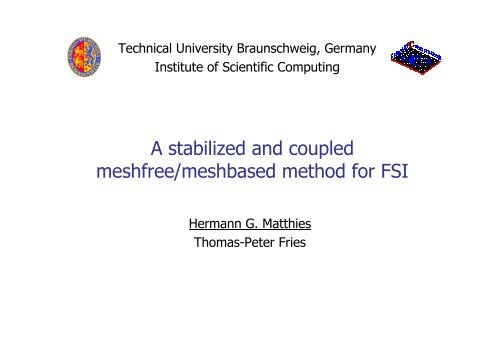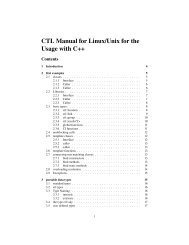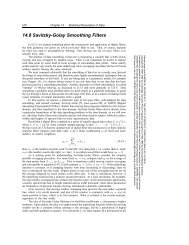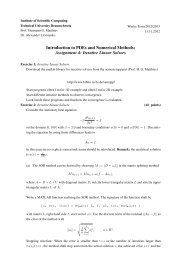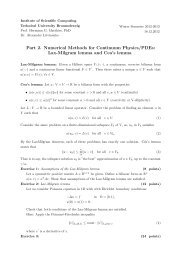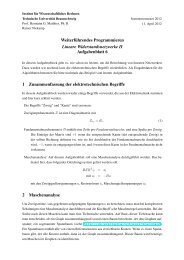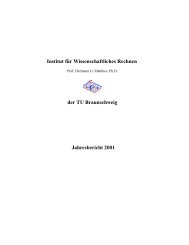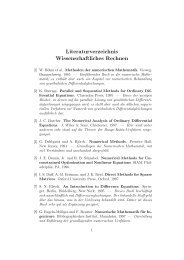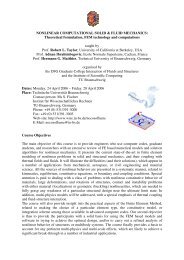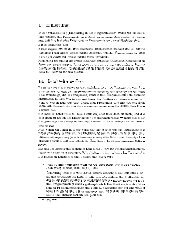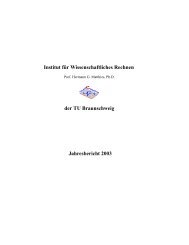A stabilized and coupled meshfree/meshbased method for FSI
A stabilized and coupled meshfree/meshbased method for FSI
A stabilized and coupled meshfree/meshbased method for FSI
You also want an ePaper? Increase the reach of your titles
YUMPU automatically turns print PDFs into web optimized ePapers that Google loves.
MotivationUse <strong>meshfree</strong> <strong>method</strong>s (MMs): no mesh needed, butmore time-consuming.Coupling: Use MMs only where mesh makes problems,otherwise employ FEM.Fluid: Coupled MM/FEMStructure: St<strong>and</strong>ard FEMTU Braunschweig Meshfree/Meshbased Method <strong>for</strong> <strong>FSI</strong> Slide: 4
Meshfree MethodMeshfree <strong>method</strong> <strong>for</strong> the fluid part:Approx. incompressible Navier-Stokes equations.Moving least-squares (MLS) functions in a Galerkinsetting.Nodes are not material points: allows Eulerian or ALE<strong>for</strong>mulation.Closely related to the element-free Galerkin (EFG)<strong>method</strong>.For the success of this <strong>method</strong>,Stabilization <strong>and</strong>Coupling with <strong>meshbased</strong> <strong>method</strong>sis needed.TU Braunschweig Meshfree/Meshbased Method <strong>for</strong> <strong>FSI</strong> Slide: 5
StabilizationThe stucture of the stabilization <strong>method</strong> may be applied to<strong>meshbased</strong> <strong>and</strong> <strong>meshfree</strong> <strong>method</strong>s.The stabilization parameter requires special attention: MLS functions are not interpolating ⇒ different character.St<strong>and</strong>ard <strong>for</strong>mulas are only valid <strong>for</strong> small supports.τSUPG/PSPG-stabilization turned out to be slightly lessdiffusive than GLS.TU Braunschweig Meshfree/Meshbased Method <strong>for</strong> <strong>FSI</strong> Slide: 11
CouplingOur aim is a fluid solver <strong>for</strong> geometrically complexsituations.MMs shall be used where a mesh causes problems, in therest of the domain the efficient <strong>meshbased</strong> FEM is used.The coupling is realized on shape function level.Meshbased areaTransition areaΩ FEM Ω *Ω MLSMeshfree areaTU Braunschweig Meshfree/Meshbased Method <strong>for</strong> <strong>FSI</strong> Slide: 12
CouplingCoupling approach of Huerta et al.: Coupling withmodified MLS technique, which considers the FEMinfluence in the transition area.NMLSiTFEM T( x) = [ p ( x) − ∑ Nj ( x) p ( xj ) ]M−1j∈IFEM( x) w( x − x ) p( x )Modifications are required in order to obtain <strong>coupled</strong>shape functions that may be <strong>stabilized</strong> reliably.iiTU Braunschweig Meshfree/Meshbased Method <strong>for</strong> <strong>FSI</strong> Slide: 13
CouplingOriginal approach of Huerta et al.w( x − xi)Ω FEM Ω * Ω MLSFEM *Modification: Add MLS nodes along Ω I Ω <strong>and</strong>superimpose shape functions there.w( x − xi)Ω FEM Ω * Ω MLSρ > 2.0∆xiρ > 1.0∆xiTU Braunschweig Meshfree/Meshbased Method <strong>for</strong> <strong>FSI</strong> Slide: 14
Couplingoriginal:modified:Ω FEMΩ *Ω FEMΩ *Ω MLSΩ MLSSuperimpose FEM <strong>and</strong> MLS nodes alongsmaller supports ⇒ reliable stabilization.Ω FEM \ Ω *The resulting <strong>stabilized</strong> <strong>and</strong> <strong>coupled</strong> flow solver has beenvalidated by a number of test cases.⇒TU Braunschweig Meshfree/Meshbased Method <strong>for</strong> <strong>FSI</strong> Slide: 15
Fluid-Structure InteractionSituation:Ω Fstructure domainfluid domainΩ SΓ CStrongly <strong>coupled</strong>,partitioned strategy:traction alongΓ CFluid: <strong>coupled</strong>MLS/FEMStructure: FEMΩ Ffluid domain+mesh velocityMesh movementdisplacementofΓCTU Braunschweig Meshfree/Meshbased Method <strong>for</strong> <strong>FSI</strong> Slide: 16
Numerical ResultsVortex excited beam (no connectivity change)TU Braunschweig Meshfree/Meshbased Method <strong>for</strong> <strong>FSI</strong> Slide: 17
Numerical ResultsTU Braunschweig Meshfree/Meshbased Method <strong>for</strong> <strong>FSI</strong> Slide: 18
Numerical ResultsRotatingobjectTU Braunschweig Meshfree/Meshbased Method <strong>for</strong> <strong>FSI</strong> Slide: 19
Numerical ResultsConnectivity changes due to large nodal displacements.TU Braunschweig Meshfree/Meshbased Method <strong>for</strong> <strong>FSI</strong> Slide: 20
Numerical ResultsTU Braunschweig Meshfree/Meshbased Method <strong>for</strong> <strong>FSI</strong> Slide: 21
Numerical ResultsTU Braunschweig Meshfree/Meshbased Method <strong>for</strong> <strong>FSI</strong> Slide: 22
Numerical ResultsMoving flapTU Braunschweig Meshfree/Meshbased Method <strong>for</strong> <strong>FSI</strong> Slide: 23
Numerical ResultsThe flap is considered as a discontinuity.“Visibility criterion” is used <strong>for</strong> the construction of the MLSfunctions.TU Braunschweig Meshfree/Meshbased Method <strong>for</strong> <strong>FSI</strong> Slide: 24
Numerical ResultsConnectivity changes due to “visibility criterion”.TU Braunschweig Meshfree/Meshbased Method <strong>for</strong> <strong>FSI</strong> Slide: 25
Numerical ResultsTU Braunschweig Meshfree/Meshbased Method <strong>for</strong> <strong>FSI</strong> Slide: 26
SummaryMeshfree Method: ALE-<strong>for</strong>mulation, MLS functions in aGalerkin setting ⇒ similar to EFG.SUPG/PSPG-Stabilization in extension of <strong>meshbased</strong>approach.Approach of Huerta et al. modified <strong>and</strong> extended bystabilization <strong>for</strong> coupling with FEM-fluid <strong>and</strong> FEM-solid.Method shows good behaviour, avoids remeshing.No conceptual difficulties seen <strong>for</strong> extension into 3-D <strong>and</strong><strong>for</strong> higher order shape functions.TU Braunschweig Meshfree/Meshbased Method <strong>for</strong> <strong>FSI</strong> Slide: 27


